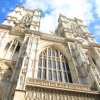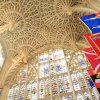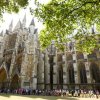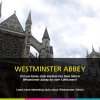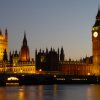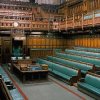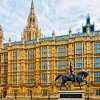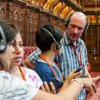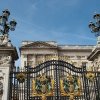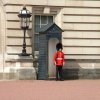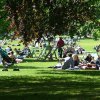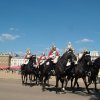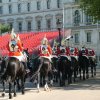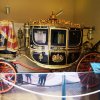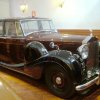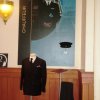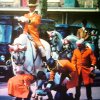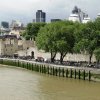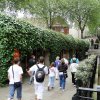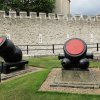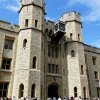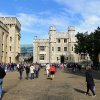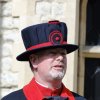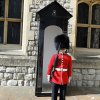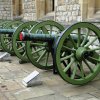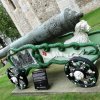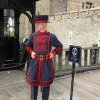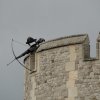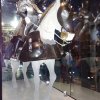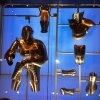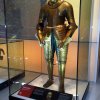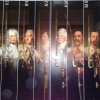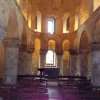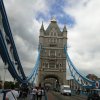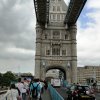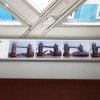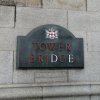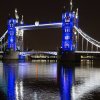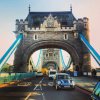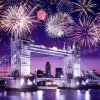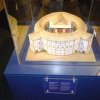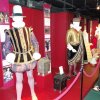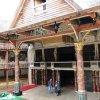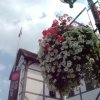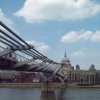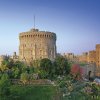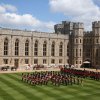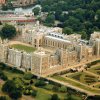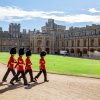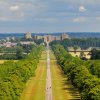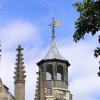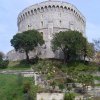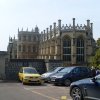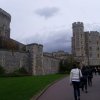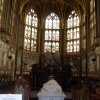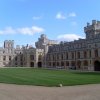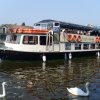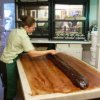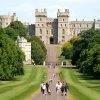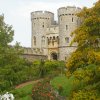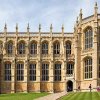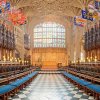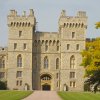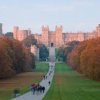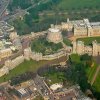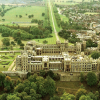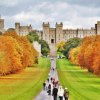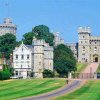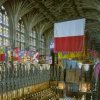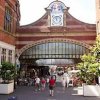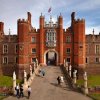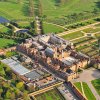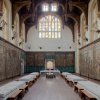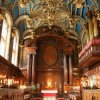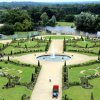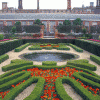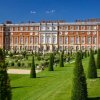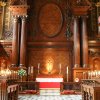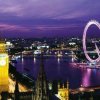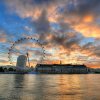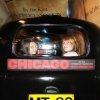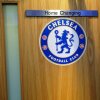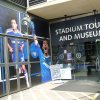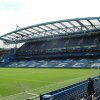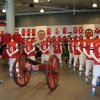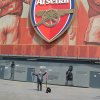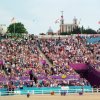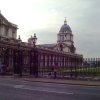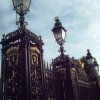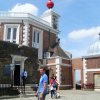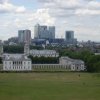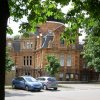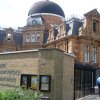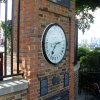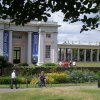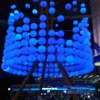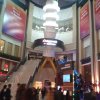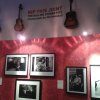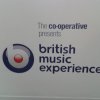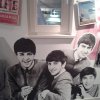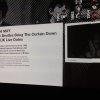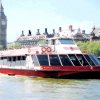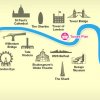Westminster Abbey
Kate & Wills' wedding venue, Westminster Abbey, the coronation church of the British monarchy since the 11th century
Just a short walk from the Thames, Westminster Abbey is a must-see and a significant structure in British history. This beautiful gothic church is a UNESCO World Heritage Site popular with many visitors to London. Complete with paintings, stained glass windows and other religious artefacts, Westminster Abbey owns the most important collection of monumental sculpture anywhere in Britain.
Highlights:
- Charles Dickens, Geoffrey Chaucer, Dr. Samuel Johnson and Charles Darwin were buried in the church's grounds
- The Abbey's history is made up of famous Kings and Queens, as well as renowned poets and priests – even heroes and villains were embroiled in its past!
- Memorial for Isaac Newton in Scientists corner
- Westminster contains impressive statues and monuments from the Virgin Mary holding a baby Jesus to the grave of the unknown warrior
- The Little Cloister which leads to the College Gardens, the oldest garden in England, where the clergy staff live
Did you know:
- In 2011 it was the venue for the wedding of Prince William and Kate Middleton
- It's been the nation's Coronation church since the crowning of William the Conqueror in 1066
- The current reigning Queen Elizabeth II was crowned on King Edward's Chair, along with every monarch since 1308
- There are 450 tombs and monuments in the Abbey
- The Chapter House has one of the oldest doors dating to 1050
- If you look closely, the walls are littered with schoolboy graffiti from the 1700s-1800s
Don't miss:
Sermons
The life of the abbey revolves around worship; Morning Prayer, Evensong and the Eucharist. The services are open to the public of any religious denomination.
Music
Westminster Abbey has been actively musical since the monks of the tenth century, to the daily choir singers of today, the Choir of Westminster Abbey. The earliest pair of organs were installed in 1304 in the Lady Chapel. Some of the most celebrated British musicians, organists, singers and composers have been linked to the Abbey throughout their careers.
Bell Ringing
Since the first established bell ringing group in 1255, the Brethren of the Guild of Westminster, the bell ringers of today are comprised of a volunteer group who ring on special occasions such as saint's days, church festivals and Royal and Abbey anniversaries.
Flag Days
On top of the North Tower, constructed between 1722 and 1745, sits a flag pole which flies various flags throughout the year for different occasions. The flags consist of; the Commonwealth Nations, the Flag of St Peter, the Abbey Flag, the Union Flag, the Flags of the National Saints, the Royal Air Force Flag, and the Royal Standard.
Find out more Westminster Abbey is deep-rooted in London's history, so explore the Abbey's past and present through our interactive infographic series.
HOUSES OF PARLAMENT
Touch but a cobweb in Westminster Hall, and the old spider of the law is upon you with all his vermin at his heels.
Henry Fox, MP and statesman, 1705-1174
The Houses of Parliament, otherwise known as the Palace of Westminster, symbolises Great Britain. Its image adorns everything from souvenirs to sauce bottles. And the decisions made in its corridors of power have shaped Britain, past and present.
The building that sits proudly on the banks of the Thames is the New Palace, built between 1840 and 1870. But within its walls is the Great Hall (or Westminster Hall), all that remains of the medieval Old Palace.
Built by William II between 1097 and 1099, it was the largest hall in England at the time, its sheer scale designed to fill his subjects with awe.
The Palace was remodelled and extended by various royal residents until the 1500s, when its role as a royal residence abruptly ended. In 1512, fire gutted the 'privy' (or private) chambers and Henry VIII decided to move to a nearby building in Whitehall. When the royals moved out, the lawyers moved in. Parliament had convened regularly at Westminster since the reign of Henry III. But Henry's break with the Holy Church in Rome, his various divorces and subsequent changes to the line of succession, gave the lawyers and politicians at Westminster plenty to do and its role as a centre for law and governance was cemented.
As home to the main Courts of Law since the late 15th century, Westminster hosted many high-profile treason trials. Guy Fawkes and his co-conspirators in the Gunpowder Plot were tried and executed in 1606. And Charles I, while still king, was tried and condemned as 'a tyrant, traitor and murderer' there in 1649 – even though no court had any legal authority over him. The Courts of Law only moved out in the 1800s.
Long unfit for purpose, the opportunity to create a new palace came in 1834, when a fire destroyed most of the old structure. The winner of the competition to rebuild was Sir Charles Barry who worked alongside Augustus Pugin to create today's Perpendicular Gothic building, containing 1,100 rooms around two courtyards. It covers eight acres with an impressive 266m river frontage. Standing proud of the main building is the clock tower, home of the bell affectionately known as Big Ben. Sadly, neither Barry nor Pugin lived to see the New Palace finished.
In fact bombs and other acts of violence have played a prominent role in Westminster's history. In 1812, Prime Minister Spencer Percival was assassinated there. A Fenian bomb in 1885 severely damaged the Common Chamber and seriously injured three. During the Blitz, the Palace was hit no less than 14 times. A 9kg bomb planted by the IRA exploded in Westminster Hall in 1974. And a car bomb exploded in the car park in 1979, killing Conservative politician Airey Neave.
Tighter security since then has prevented further tragedies. But people with axes to grind still see Westminster as the perfect backdrop to their protests: from flour-bombing Tony Blair to staging rooftop sit-ins dressed as super heroes. As the seat of governance and power, the Palace of Westminster has been making the news since the 11th century – and it doesn't show any signs of stopping.
BUCKINGHAM PALACE
This is the official residence of the British monarch, Queen Elizabeth II; it is used for official events, State occasions and ceremonies by the Royal Family. The palace is conveniently located close to central London and accessible by the London underground. The palace is surrounded by public Royal Parks: Green Park, St. James Park and Hyde Park.
The royal home has the largest private garden in London. The façade is in the French neo-classical style and was part of architect John Nash's design. The palace building covers 77,000m² and key rooms include the Music Room, the Blue, Green and White Drawing Rooms, Throne Room and the Picture Gallery. Works by Vermeer, Rubens, Rembrandt and other masters are displayed in the Picture Gallery which connects the State Rooms together. In the semi-state apartments are the 1844 Room, the Bow Room and the Red and Blue Chinese Luncheon Room. The rooms are decorated with antique furniture and valuable art.
The building was originally a townhouse belonging to the Duke of Buckingham in 1705; in 1761 King George III bought the property and through the 19th century the palace was extended and renovated. When Queen Victoria ascended to the throne in 1837 the palace became the monarch's official residence.
Tourists come to the palace to watch the pageantry of the Changing of the Guard performed by the Royal guards who wear their distinctive red uniforms and black tall furry hats. During the ceremony (at 11:30 daily in summer and every other day in winter) the guards march from nearby Wellington Barracks to the front gate of the palace and replace the Old Guard of their duty. On special occasions like a coronation, wedding or jubilee the Royal family comes out onto the balcony on the East front of the building to greet the crowds of supporters in the street below. The public can tour the palace state rooms during the Summer Opening in August and September. The public can visit the Queen's Gallery where there are exhibitions of work from the Royal Collection.
TOWER OF LONDON
See the world-famous Crown Jewels and meet the Beefeaters on a tour of the highlights at the Tower of London
The Tower of London is one of the world's most famous fortresses and has seen service as royal palace, prison, armoury and even a zoo. The ancient stones hold within them dark secrets, as fortified vaults shine with priceless jewels and historic uniformed Beefeaters stroll the grounds. Situated in Central London, just a stone's throw from the River Thames, the Tower of London is one of the city's premier attractions.
Highlights:
- Rich history dating from the Norman Conquest
- It has undergone amazing restoration over the centuries, including damage from the Blitz
- Used by Royals through the years as a refuge and powerbase
- The Tower is still home to her Majesty's Crown Jewels, on display for visitors to see
- The Beefeaters are tasked with the job of guarding the jewels, as well as acting as tour guides for the attraction
Did you know:
- There are 12 acres of land within the walls
- It was initially resented by the people of London when it was built, as it stood as a symbol of oppression by the new ruling forces
- It has been used as an armoury, a menagerie, a treasury and a prison
- The term 'sent to the Tower' was coined during the 16th and 17th century when those who had fallen into disgrace were sent there
- The prisoners entered through the water gate, called 'Traitor's Gate'
- The White Tower is a fortified tower, called a keep and houses the crypt of St John's Chapel
- The Tower is said to be haunted by the ghost of Anne Boleyn walking the chapel of St Peter and Vincula
Don't miss:
The White Tower
One of the most famous keeps in the world, this Tower is so renowned that it was referred to by Shakespeare in many of his plays. It contains the impressive Royal Armouries collections and even an 11th century Romanesque chapel. You can take daily tours of the White Tower at 10:45, 12:45 and 14:15.
The Royal Mint
Explore the Coins & Kings exhibition which depicts the story of the Mint at the Tower between 1279 and 1812. Learn about what life was like on Mint Street through outdoor installations and interactive displays, even fun facts about Isaac Newton and his thief catching skills.
Crown Jewels
Take a walk through history and learn about some of the most important symbols of our culture and monarchy. Try and count the 23,578 gems that make up the Crown Jewels and marvel at the stories of how the collection was nearly destroyed through history. You can even see the crown Elizabeth II wore to her coronation!
Royal Beasts
For 600 years the Tower was kept as a menagerie of wild and exotic animals; gifts that the King and Queen were donated by their visitors and admirers. Everything from ostriches to elephants, lions and polar bears were kept in the confines of the Brick Tower.
Ravens
If the six resident ravens ever leave the court, legend has it that the court and the tower will fall. The ravens who inhabit the Tower are named and are replaced if they are badly behaved! Currently the Tower has seven ravens, in case one goes missing, and they are looked after by the Raven Master. A word of warning: don't approach the ravens as they're known to eat 170g of raw meat a day, as well as blood-soaked bird biscuits!
Yeoman Warder Tours
Yeomen, aka Beefeaters, were so called because centuries ago as part of the Royal Bodyguard they were allowed to eat as much beef as they wanted from the king's table. Nowadays, the Yeomen Warders qualify for the privilege after serving in the armed forces for 22 years.
Tours are included in the price of an entry ticket, and depart every 30 minutes (last tour 15.30 in summer, 14.30 in winter). Tours last approximately 60 minutes and start near the main entrance.
If you've got small kids, don't worry! There's no need to keep them entertained the hard way, the Tower of London provides family fun trails and interactive touchscreens at the exhibitions to keep even the little ones happy!
TOWER BRIDGE EXIBITION
Visit Tower Bridge's new Glass Walkway, one of London's most unique experiences, and learn about the Victorian steam bascules
Tower Bridge is one of the most impressive structures and sites in the capital and has stood over the River Thames since 1894. As well as being one of the most recognizable landmarks in the world, it is one of the most visited attractions in London and continues to be a working bridge to this day.
The Tower Bridge Exhibition lets you discover the history of the Bridge and how it was built, through interactive displays and videos about the landmark its place in the history of the River Thames.
Highlights:
- NEW Glass Floor walkway for a unique experience of the bridge
- Spectacular panoramic views over the river
- The "bascule" bridges (which mean see-saw in French) are lifted to this day on a schedule to allow boats and barges to pass
- Tower Bridge Exhibition explores the Bridge's history and development through time as a fully functioning bridge and offers a high-level walkway across the two towers
Did you know:
- When London Bridge was built it was originally the only crossing over the Thames
- Over 50 designs were submitted to be considered for the winning design
- The build of the bridge took 8 years to build with 432 construction workers
- Before 1977 the bridge was brown until it was painted red, white and blue to celebrate the Queen's Jubilee
- A London bus driver once had to jump between the two raising 'bascules' when his number 78 bus was caught on the bridge as it rose
Don't miss:
Glass Walkway - NEW!
The Tower Bridge Exhibition has just launched it's most significant development since 1982 - the glass walkway. Housed in the West Walkway, visitors can admire Tower Bridge from a unique perspective and look down on passing boats and pedestrians underfoot and even catch the bascules rising if you time it right. From 42m above the river, the glass walkway is a must-see - if you need any more convincing, the glass is made up of five thick layers and can hold the equivalent weight of an elephant and two taxis. So you're pretty safe!
Victorian Engine Rooms
The Victorian Engine Rooms hold the coal driven steam engines that were once used to power the bridges. Interactive information panels help visitors discover the development of technology used over the years to keep the bridge in motion, complete with sounds and smells that take you back through time. You can also experience a virtual Bridge lift illustrating how the bascules are raised.
East Walkway
Experience the breath-taking views from the high-level walkway, East Walkway, and observe the wealth of museums and historic buildings that surround the Thames, including HMS Belfast and the Tower Of London. The East Walkway also houses the exhibition 'Great Bridges of the World' showcasing over 20 bridges of inspiring engineering
Find out more about London's finest bridge and explore and it's symbolic history - including a few near misses and a paint job with our interactive infographic series.
LONDON BRIDGE EXPERIENCE
London Bridge and brave the haunting tales of the city's notorious past at the London Bridge Experience
The London Bridge Experience is a unique and interactive journey through the deep, dark history of London. Travel through time and take a light-hearted look at 2000 years' worth of history within London Bridge and the surrounding area. Watch Boudicca fight her battles against the Romans, get twisted up in the fates of traitors and their treachery but beware to keep your head! Be engulfed in the powerful Great London Fire and follow the gruesome and gory tales of Jack the Ripper. Finally, for those who dare, enter the bowels of the Bridge and be terrified, tormented and tricked within The Tombs.
Highlights:
- Scariest attraction in London
- Rich history of gruesome, gory Britain
- Interactive experience with real life actors and animation
- Two part attraction; The London Bridge Experience and London Tombs
Did you know:
- The legend of the disfigured Mastern Brother's vengeful murders haunts London with the killings of four men on Tower Bridge
- Workers at The London Bridge Experience have heard eerie children's cries and have witnessed poltergeist activity whilst on shift
- The Great Fire of London (1666) has no official death toll, but the heat of the fire may have cremated many Londoners, leaving their remains unrecognisable
- The murders of Jack the Ripper have inspired many studies and analyses of his case, the term has now been coined Ripperology
- Many phantom cries can be heard at London Bridge rumoured to be 'traitors', whose heads were dipped in tar and stuck on pikes, executed between 1305 and 1660
Don't miss:
- The London Bridge Experience can teach you about life in London from the Roman times, to the fierce battles of Queen Boudicca and 19th century pick pocketing thieves. Discover the darkness of a disused railway tunnel, the traitor's Gate House and the Chapel of Thomas Beckett.
- A former 16th century plague pit, the London Tombs prides itself on its unbeatable scare-factor. From terrifying tales and true stories, explore the gruesome past of London Bridge with a spine-tingling adventure into the depths of the tomb.
SHAKESPEARE ’ S GLOBE THEATRE
Visit the reconstruction of Shakespeare's historic 16th century playhouse and take a behind-the-scenes tour of the open-air Globe Theatre
Shakespeare's Globe Theatre is an open-air playhouse built as a reconstruction of the building where the great playwright penned many of his plays. The Shakespeare's Globe Theatre Tour and Exhibition introduces visitors to all aspects of the Globe, historical and contemporary, including Sam Wanamaker's epic struggle to recreate the theatre from the 1599 original.
Highlights:
- Reconstruction of the original Elizabethan playhouse built In 1599
- Authentic timber frame building with an open-air stage
- To maintain the true sense of a Shakespearean play and experience, there are no spotlights, microphones, speakers or amplification and all music is performed live on period instruments
Did you know:
- Shakespeare wrote 37 plays and 154 sonnets during his lifetime – this works out as an average 1.5 plays a year since he first started writing in 1589
- As well as being a playwright, Shakespeare was an accomplished actor, family man, property owner and manager of an acting company and theatre
- The original theatre burnt down in 1613 because of a miss-fired cannon during a Henry VIII performance
- His plays are associated with the Elizabethan times, yet most of his popular works were written in the Jacobean era
- Although he was a famous playwright in London, in his hometown of Stratford he was a well-known businessman and property owner
- At his grave in Stratford-upon-Avon, he put a curse on his epitaph daring anyone to move his bones to give way for more grave space, as was common at the time
Exhibitions
There are a number of temporary and permanent exhibitions and galleries at the Globe throughout the year. Among these include 'The Festival in Focus', photographs of over 600s performers captured on stage, audience reactions and behind the scenes stories. Created by a group of leading theatre photographers it is an honest and insightful portfolio of the diverse and vibrant performances at the Globe.
Open air stage
The stage is open to the elements which can make drizzly performances in the summer even more exciting (no umbrellas allowed!) With a lack of spotlights, microphones and speakers you are encouraged to interact with the actors through realistic staging and authentic props. The seating consists of covered wooden benches and the yard is standing only.
Sam Wanamaker Theatre
The Sam Wanamaker Theatre is the site's indoor Jacobean theatre, a simulacrum of the 16th century Blackfriars Theatre, on the opposite bank of the Thames. Having recently opened, it has a packed all-year-round programme including productions of Julius Caesar, Anthony & Cleopatra, A Bach Family Celebration and many more exhibitions and events.
WINDSOR CASTLE
Visit the Queen's favourite weekend residence and see the Changing of the Guards at the historic Windsor Castle
Factor in a short trip outside London to visit the impressive and historic Windsor Castle. Famous for its architecture and longstanding Royal place of residence, the Castle was built in the 11th century after the Norman invasion. As well as having been used as a military headquarters during the Civil War and as a refuge for the royal family during WWII, Windsor Castle is now Queen Elizabeth II's favourite weekend home.
Highlights:
- Oldest and largest occupied castle in the world
- Preferred weekend residence of the Queen
- Built over 900 years ago and is steeped in royal history and antique furnishings
- Traditional State Apartments and Queen Mary's Doll House
Did you know:
- Windsor Castle grounds cover nearly 5 hectares
- During the Blitz in World War 2, the windows of Windsor Castle were blacked out and the royal bedrooms were strengthened in case the castle was bombed
- St George's Chapel is deemed one of the most beautiful and impressive buildings in England and is the burial place of 10 monarchs
- The Long Walk, a paved avenue of trees, runs south of the castle for 3 long miles in a straight line
- The exclusive and renowned school Eton College (where Prince William and Harry were educated) is situated about half a mile from the castle
- As of 2006, around 500 people were living and working in the castle
Don't miss:
- Changing of the Guards
- Catch the traditional military parade and Changing of the Guards up the high street and into the castle to the Lower Ward. The ceremony lasts 30 minutes and starts at 11:00 (but you can catch the march up the hill at 10:50) and weather permitting they're accompanied by a band. The Guard March takes place all year round on alternate days from August to March and daily during April, May, June and July (apart from Sundays).
Note: The Changing of the Guards schedule is set by the British Army. Best check the Royal Collection's website for latest information and updates.
State Apartments
Home to over 39 monarchs, Windsor Castle has seen the tastes and décor vary hugely over the centuries. The State Apartments pay homage to the differing tastes of the royal occupants from lavish furnishings and treasures from the Royal Collection, including masterpieces by Rubens, Holbein, Brueghel and Van Dyck.
London Pass holders get a free self-guided audio tour that lasts around 2 hours.
Queen Mary's Dolls House
Built by the leading architect Sir Edwin Lutyens for Queen Mary in the early 1920s, this dolls house is the largest and most intricate in the world. The scale is tiny, at 1:12, and the house is filled with one-off specially commissioned pieces from leading artists and craftsmen. Observe the minute detail of the library, wine cellar and marvel at the facilities, including running water and electricity.
St George's Chapel
This Gothic masterpiece is one of the finest examples of its style of architecture in the country. It is the home of the Order of the Garter, established in 1348, and houses the tombs of ten sovereigns including Henry VIII.
Open Monday – Saturday: The Chapel closes at 16:15 (last entry 16:00) in order to prepare for the evening service at 17:15 (doors open at 17:00)
Waterloo at Windsor 1815 - 2015
2015 marks the 200th anniversary of the Battle of Waterloo and the defeat of Napoleon. In celebration of the allied victory, George IV created the Waterloo Chamber at Windsor Castle, a grand space filled with portraits of those instrumental in the victory, among them the Duke of Wellington.
Throughout 2015, Waterloo at Windsor: 1815–2015 will combine a themed trail through the State Apartments with a display of prints, drawings and archival material that explores the battle and its aftermath.
The trail will highlight objects seized on the battlefield by the victors, including silver, furniture, weapons and the beautiful red cloak belonging to Napoleon, presented to George IV by Wellington's ally, Field-Marshal Gebhardt von Blücher. Running 31st January 2015 - 13th January 2016.
Find out more about this Royal retreat and Windsor Castle's dramatic history. From fun facts and monarchic milestones, explore the past and present of the world's oldest and largest occupied castle with our interactive infographic series.
HAMPTON COURT PALACE
King Henry VIII's enormous Tudor Kitchens, the world-famous maze and original 17th century tennis courts at Hampton Court Palace
Hampton Court Palace is the former home of the flamboyant King Henry VIII. He extended and developed this grand palace after acquiring it in the 1520s and its many royal occupants have furnished the palace with decadent tapestries and paintings throughout the centuries. Set in 60 acres of formal gardens, including the famous maze and Great Vine, this palace is well worth a visit.
Highlights:
- The Great Vine vineyard that was planted in 1769 (submitted to Guinness World Book 2005)
- The Maze, apparently the most famous maze in the world, according to Ernest Law
- Enormous Tudor kitchen built to feed the entire court
- Hampton Court Gardens span over 60 acres of lush greenery, parkland and plantations
- Henry VIII's crown sits on display in the Royal Pew as a model of the original
Did you know:
- Hampton Court Palace is believed to be haunted by a screaming lady thought to be Catherine Howard, and the grey ghost Dame Sybil Penn is believed to roam the Clock Courts
- The truth behind Charles I's mystery disappearance in the summer of 1647 is still disputed when he fled the posh prison of Hampton Court and left on a boat to the Isle of Wight
- Hampton Court Gardens displays over 200,000 flowering bulbs on display throughout spring
- The Great Hall, England's last and greatest Medieval hall, saw the performance of Shakespeare's company the 'King's Men' in 1603
- Three of the walls that surround the tennis court date back to the 17th century, one of them being Cardinal Wolseley's original
Don't miss in your tour:
Guided Tours
Enjoy free guided tours of Hampton Court Palace and be taken around this historic landmark by costumed tour guides, bringing the tales of the palace to life. Learn about court scandal and gossip in these interactive guides (audio guides also available upon request).
The Great Vine
Planted in 1769 the vineyard is a longstanding feature of Hampton Court Palace. Its original name is 'Shiva Grossa' which means Black Hamburg. The vine is still cultivated through the Victorian extension method, which involves a glasshouse. The grapes are usually ripe after the August Bank Holiday and are sold during the first three weeks of December – in the past, the grapes were sent to Windsor Castle for Queen Victoria.
The Crown
A replica of the crown that was made for Henry VIII, and was worn at the coronations of each of his children, sits in the Royal Pew on display for visitors. It stands as a symbol of power, monarchy and religious authority. The original was melted down at the Tower of London by decree of Oliver Cromwell in 1649. The replica was built from the detailed descriptions of Henry VIII's servants who itemised the size and position of each 344 rubies, sapphires, emeralds, diamonds and pearls that embellish the crown.
Chapel Royal
The Chapel Royal delivers traditional services throughout the year and is a masterpiece of religious architecture with a rich colourful design in Tudor style. Kings and queens sit in the private pew which looks down the main body of the chapel and it was even here, in 1540, where Archbishop Cranmer handed Henry VIII the letter accusing Catherine Howard of her adulterous behaviour.
Hampton Court Gardens
Hampton Court Gardens are a horticultural feat to be admired. The park covers 750 acres and the formal gardens cover 60 acres. Within the Court Gardens lies the Great Vine, The Privy Garden – a recreation of the 1702 garden for William III, Tiltyard Walls, Home Park – 700 acres of deer park with ponds and wild birds, not to mention the Palace Maze from 1690, made up of half a mile of winding passages between 7ft high yew trees.
Tudor Kitchens
A testament to Tudor dining, Henry VIII's kitchens at Hampton Court are the largest kitchens of their era. Built between 1530 and 1737, the kitchens served up to 600 people twice a day, as well as the royal banquets. Working in the kitchens was hot and dirty – a Spanish visitor in 1554 even called it a 'veritable hell'. The cooks would often lie by the fire in very little clothes and would drink on the job, having access to all the beer supply.
Click here for a Hampton Court Palace map to help you on your visit.
Find out more about Hampton Court Palace and the infamous Henry VIII's habits and hobbies; as well as his celebrity guests (including Shakespeare)in our interactive infographic series.
LONDON EYE
Madame Tussauds London
- Take pictures with incredible waxworks of some of the world’s biggest stars, including One Direction, David Beckham and even the Queen
- See superheroes brought to life on a huge 360° screen in the 4D Marvel Superheroes movie
- Take a journey through London’s fascinating history on a thrilling theme park-style ride
- Step into your favourite Star Wars scenes and come face to face with the movies’ heroes & villains, including Princess Leia, Luke Skywalker and even Jabba the Hutt
- Save over 20% compared to buying on the day
- Tickets are open-dated and can be used any time
- Guaranteed entry on the day – exclusive to tickets bought in advance
- Family tickets include a free colour guide book
- A spectacular and exclusive 4D Marvel Superheroes movie
- A theme park-style taxi ride through London’s fascinating history
- The chance to take a penalty in front of footballing legends David Beckham and Cristiano Ronaldo
- Taking centre stage with Kylie Minogue for a pop duet
CHELSEA FC
The grounds of Chelsea Football Club and experience what life is like as a player, behind-the-scenes of this iconic team
Stamford Bridge is home to Chelsea Football Club, a popular football team playing in the English Premier League. Chelsea's Stamford Bridge stadium is a great example of the grandeur and importance of the national game.
Part of the Chelsea FC Stadium Tour is a visit to the changing rooms where Chelsea's world famous squad spends many tense and season-defining moments. You will also experience the atmosphere of this enigmatic space and relive the drama experienced there both in recent and historic games.
The legacy of Chelsea FC is immense and as part of your Chelsea tour you will be offered the chance to visit areas usually reserved for the players on a match day, including the dugouts and the press room, with many photo opportunities.
Visitors to Chelsea FC can also experience the Chelsea Museum, an interactive tour of into the prestigious history of the football club. The museum brings to life through fun, interactive and user friendly exhibitions one of the most engaging and fascinating stories of modern football. It's not to be missed whether you are Chelsea fan or not.
Arsenal Fc
Top premiership football club – Arsenal FC. The Arsenal Stadium Tour takes visitors into some of the most intimate areas of the club and gives them a taste of what it is like on Match Day.
From the changing rooms to the Tunnel to media interview rooms, the Arsenal Stadium Tour features all of the key highlights of the glamorous stadium.
The Emirates Stadium is a modern marvel with a capacity of over 60,000 it was built 2006 on a plot of land adjacent to the former home to Arsenal, Highbury. The stadium is a triumph of modern sports stadia architecture and was the centre piece of a wider regeneration project of the surrounding area.
The tour comes complete with a visit to the Arsenal Museum for a look into the history of this top Premier League football club.
Wembley Stadion
Visit the England Football Team's home turf, Wembley Stadium, and take a behind-the-scenes tour of the players tunnel and team changing rooms
Wembley Stadium is London's largest and most prestigious sporting stadium. It is the home of the England football team, the venue for all domestic club competitions such as the world famous FA Cup and host of both the 2011 and 2013 UEFA Champions League Finals.
Opened in 2007 this impressive structure took over 4 years to build at a cost of over £790m and has over 90,000 seats. The new stadium is built on the same site in North-West London as the original stadium which hosted the 1948 Olympic Games and the 1966 World Cup Final, famously won by the hosts - England!
Since opening Wembley Stadium has played host to the first NFL game outside of North America, an event which has become an annual affair, and hosted the football finals at the 2012 London Olympics.
Each 75 minute tour takes visitors behind the scenes with access to the exclusive Club Wembley Middle Tier, England dressing rooms and Press Conference Room. Visitors get to experience the tension of the tunnel which leads players out to the pitch before a big game and then climb the 107 steps to the Royal Box where winners collect their trophy. At the end of the tour, all visitors can enjoy 'The Exhibition of Champions'; a stunning free visitor attraction celebrating 56 years of glorious European Football history. It features prize exhibits including inspirational Liverpool skipper Steven Gerrard's 2005 captain's armband, David Beckham's jersey from Manchester United's victorious 1999 campaign and Graeme Souness' three winners' medals from '78, '81 and '84.
The Wembley Stadium Tour is something that should not be missed by any sports fan visiting the city.
GREENWICH
Greenwich is a beautiful and historic South London area. Learn about Britain's naval history, catch a show at the Planetarium and hop over the Greenwich Meridian line
Pinterest
Greenwich is a historically rich area of London with lots of green space. It is also a great place to visit for entertainment, food and drink. This makes Greenwich a popular area for family days out in London.
Geographically, Greenwich sits on the southern banks of the River Thames just south of Docklands and Canary Wharf.
Travel to Greenwich
There are various ways to travel to Greenwich village. Travel by Tube on the Jubilee line to North Greenwich station. If you take the Docklands Light Railway (DLR), alight at Cutty Sark, or at Island Gardens and walk through the Greenwich Foot Tunnel.
If you're arriving by overground train, Greenwich station is a five minute walk to the village centre.
Alternatively, take a relaxing boat ride to Greenwich Pier with MBNA Thames Clippers, or a river cruise with City Cruises.
Most see in Greenwich
Spend a day out in Greenwich soaking up the romantic baroque architecture, admiring the impressive views of London, and learning about science, navigation and history.
When visiting Maritime Greenwich, you'll be on one of London's world heritage sites. When the weather is warm and sunny, Greenwich Park makes an ideal spot for a picnic.
Discover the Royal Museums Greenwich collection, which is comprised of:
the National Maritime Museum, home to an impressive collection of naval art and materials relating to Britain's seafaring history
the elegant Queen's House with its superb collection of fine art
the Cutty Sark, one of the world's most famous ships and the last surviving tea clipper
the Royal Observatory with views over the river Thames towards London's Canary Wharf
the Observatory's Peter Harrison Planetarium, where you can catch a spectacular show
In Greenwich you'll also discover the Old Royal Naval College, a free to enter landmark which stands on the site of Greenwich Palace, Henry VIII's favourite royal residence. Seek out The Painted Hall – perhaps the finest baroque dining hall in the UK – which was designed by Christopher Wren and painted by James Thornhill.
For those who require accessibility facilities, check out our one-day itinerary for accessible Greenwich.
Things to do in Greenwich: Entertainment
Greenwich is also home to some of the biggest events in London. Experience Europe's largest live music concerts and events at The O2 Arena. It is the world's busiest arena and has hosted famous stars such as Beyoncé, Michael Bublé, and Madonna. Sporting events such as the tennis ATP World Tour Finals are also hosted here.
Find the more intimate live gigs at IndigO2 and Brooklyn Bowl, where, as the name suggests, you can also test your tenpin bowling skills. Catch the latest blockbuster movies at The O2 multi-screen cinema, and dine at a variety of restaurants and bars. See the world from outside the dome with an Up at the O2 climb across the top.
Watch theatrical performances at the Greenwich Theatre or catch live comedy at Up The Creek.
Look out for special events happening in Greenwich throughout the year such as the Greenwich+Docklands International Festival in June.
Things to do in Greenwich: Shopping
The village of Greenwich is a great destination for quirky clothes and stylish furnishings. The Greenwich Clocktower Market is where you'll find vintage and craft items.
Check out the covered Greenwich Market, running from Tuesday-Sunday. The market is filled with arts, crafts and food stalls on Tuesday, Wednesday, Friday, Saturday and Sunday. You will find bric-a-brac, antiques and vintage clothing on Tuesday, Thursday and Friday.
Things to do in Greenwich: Restaurants and Bars
For great food with a view in Greenwich, head to the Gipsy Moth next to the Cutty Sark, or the beautiful Trafalgar Tavern on the banks of the Thames. For a special occasion, try the Rivington Grill or the North Pole Piano Restaurant.
Beer lovers will want to book a table at the The Old Brewery at Meantime Greenwich (where they produce their own tipples).
If you're travelling on a budget, Elements, Mogul Indian Restaurant, and Bianco43 all welcome hungry explorers.
There are also a number of bars and restaurants at The O2 in North Greenwich such as Rodizio Rico, Gaucho, and Zizzi.
Learn more about the history and industrial heritage of this area at the Greenwich Heritage Centre.
Military enthusiasts will love Firepower - The Royal Artillery Museum and its impressive collection of tanks, cannon and armoury. It tells the story of arms from before the creation of gunpowder to the modern day. The Field of Fire multimedia show is a great experience for kids, with a shaking floor, dry ice and loud explosions to bring the history of weaponry alive. In the Camo Zone you can test your skills on the Firing Range, and show your strength on the Bungee Run.
British Music Experience
Thames River Boat
Unique views across London from the Thames and see the riverside sights of Big Ben, Tower Bridge, the Shard and HMS Belfast
A Thames river cruise is without doubt one of the best ways to see London, meandering through the heart of the city and past so many of its most famous attractions. See and experience the sights and splendour of this great city from the relaxed comfort of City Cruises modern, all-weather boats with open upper decks and spacious lower saloons with panoramic windows.
Tour durations: options from 30 minutes, to 3 hours
Four locations to hop-on and hop-off:
Did you know:
The Thames River is the longest river in London; it stretches to 215 miles long
You'll often find rowers and kayakers using the river to practice their water sports
The name is derived from the Latin Tamesis referring to 'dark' and was called the Temese in Middle English
The River Thames contains over 80 islands
In the early 1600s the Thames River froze over and a series of tents and amusements were set up over the water – including bowling on ice!
Where to hop-on and hop-off:
Westminster Pier
If you're after some of London's most historic landmarks, Westminster Pier is a good option to explore the Houses of Parliament, Tate Britain, Churchill Museum, Westminster Abbey, Cabinet War Rooms, Buckingham Palace and Big Ben. It's a short walk from the River Thames into the hustle and bustle of Central London, into Soho, Leicester Square and Covent Garden.
London Eye
Set along London's famous Southbank area, you can immerse yourself in the "cultural heart" of the city. Stroll along the famous esplanade, past street performers and pop-up eateries to the more edifying landmarks such as The British Film Institute, National Theatre, Queen Elizabeth Hall and Royal Festival Hall. Further along the river, you can find Shakespeare's Globe Theatre and the Tate Modern.ű
Tower Bridge
The river cruise's most popular stop, it allows you to explore the Tower of London and Tower Bridge, two of London's most famous landmarks. With close links to the financial city and historic centre of London, you have the Monument, HMS Belfast, the Great Fire memorial by Christopher Wren and the Design Museum all within easy reach.
Greenwich
Slightly removed from the busy Central London, this pier is popular for experiencing the expanse of palatial grounds and Greenwich Park, as well as the independent shops the area has to offer. The newly refurbished Cutty Sark is open to explore and learn about its nautical past. Not far is the National Maritime Museum, Greenwich Market as well as the Royal Observatory Greenwich.

